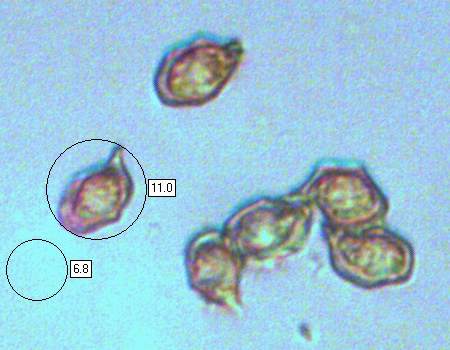Entoloma mougeotii (Fr.) Hesler
Phylum: Basidiomycota - Class: Agaricomycetes - Order: Agaricales - Family: Entolomataceae
Distribution - Taxonomic History - Etymology - Identification - Culinary Notes - Reference Sources
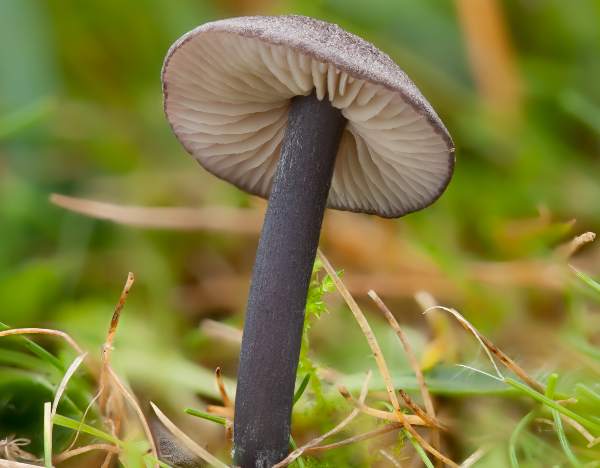
Very few mushrooms are blue, and Entoloma mougeotii is one of the 'chosen few', most of which belong in the genera Entoloma or Cortinarius. (Other blue Entoloma species include Entoloma Bloxamii, which is a chunky Tricholoma-like mushroom; Entoloma chalybaeum; Entoloma nitidum; and Entoloma serrulatum.) All of the blue pinkgills are rare or uncommon to rare, and Entoloma mougeotii is such a rare find that it has not been given a formal common name in the British Mycological Society's list of recommended English names of Fungi.
Distribution
Entoloma mougeotii is a very rare find in Britain and Ireland; this attractive little mushroom occurs throughout much of mainland northern and central Europe, where it is also very rare. It is also recorded in parts of Asia.
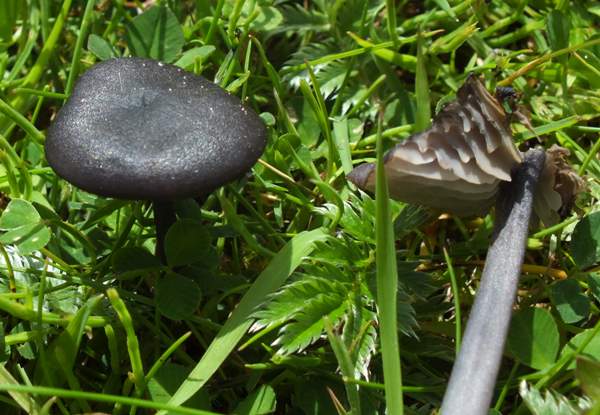
Taxonomic history
This lovely pinkgill owes its basionym to the great Swedish mycologist Elias Magnus Fries, who in describing this species scientifically in 1873 named it Eccilia mougeotii. The currently-accepted scientific name of this species dates from 1967, when American mycologist Lexemuel Ray Hesler (1888 - 1977) transferred it (with several other pinkgills) to the genus Entoloma, thus establishing its scientific name as Entoloma mougeotii.
Synonyms of Entoloma mougeotii var. mougeotii include Eccilia mougeotii Fr., Leptonia serrulata var. berkeleyi Maire,
Entoloma ardosiacum var. mougeotii (Fr) A. Pearson & Dennis, Leptonia mougeotii (Fr) P. D. Orton, and Entoloma mougeotii (Fr) Hesler.
Etymology
The generic name Entoloma comes from ancient Greek words entos, meaning inner, and lóma, meaning a fringe or a hem. It is a reference to the inrolled margins of many of the mushrooms in this genus.
The specific epithet mougeotii honours French naturalist Jean Baptists Mougeot (1776 - 1858); he was a botanist-mycologist and one of Christiaan Hendrik Persoon's most ardent correspondents and followers.
Identification guide
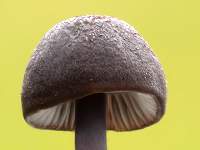 |
Cap1.5 to 4cm across; initially convex with an involute non-striate margin, and slightly umbilicate, flattening, eventually with a straight margin; not hygrophanous; dark violaceous black, becoming violaceous brown with age; cap surface is tomentose or finely scaly. |
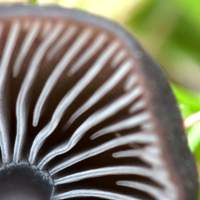 |
GillsAdnate, sometimes with a decurrent tooth, white then pink (including the sterile gill edges, a feature which clearly differentiates this species from the otherwise very similar Entoloma serrulatum). Stem2 to 6cm long and 1 to 4mm diameter, cylindrical or slightly compressed laterally; steely grey with a whitish tomentose base; initially with longitudinal silky fibrils, becoming smooth with age; no stem ring. |
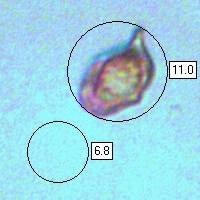 |
SporesMostly five- to eight-angled (pentagonal to octagonal) in side view; 9-11.5 x 6-8μm. Spore printBrownish pink. |
Odour/taste |
Not distinctive. |
Habitat & Ecological role |
Saprobic in grassland. |
Season |
Fruiting from summer to late autumn in Britain and Ireland. |
Similar species |
Entoloma serrulatum is similar but has black-edged serrulate gills. |
Culinary Notes
Entoloma mougeotii is far too rare to be collected for anything but essential research. Let's treat it as deadly poisonous!
Reference Sources
Fascinated by Fungi, 2nd Edition, Pat O'Reilly 2016, reprinted by Coch-y-bonddu Books in 2022.
Knudsen H., Vesterholt J. (eds) Funga Nordica: agaricoid, boletoid and cyphelloid genera - Nordsvamp, 2008
Dictionary of the Fungi; Paul M. Kirk, Paul F. Cannon, David W. Minter and J. A. Stalpers; CABI, 2008
Taxonomic history and synonym information on these pages is drawn from many sources but in particular from the British Mycological Society's GB Checklist of Fungi.
Acknowledgements
This page includes pictures kindly contributed by David Kelly.
Fascinated by Fungi. Back by popular demand, Pat O'Reilly's best-selling 450-page hardback book is available now. The latest second edition was republished with a sparkling new cover design in September 2022 by Coch-y-Bonddu Books. Full details and copies are available from the publisher's online bookshop...
